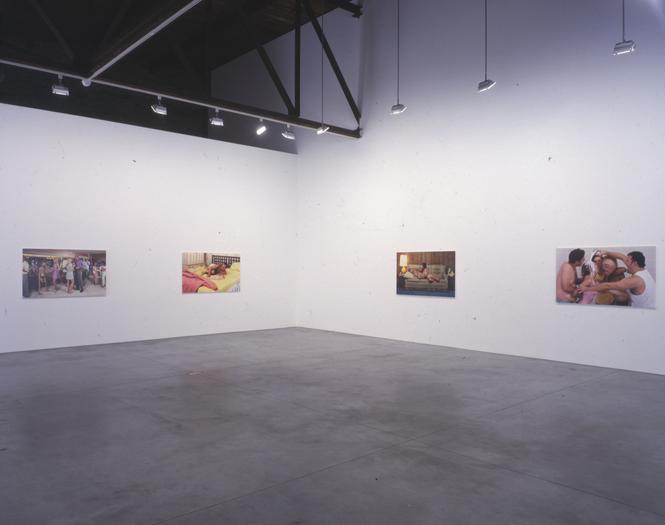Charlie White
Understanding Joshua
March 3 – April 7, 2001
Main Gallery
Who, and what, is Joshua? Joshua is a character in the physical world, and although he looks like no one you might actually meet, he can be read as an "everyman" for today's society. His features and psychology are a symbol or reflection of both our universally insecure self-consciousness and our desire to connect emotionally and physically with others. As in Charlie White's previous work, a territory between artifice and reality is used to center the psychological world of the scenarios before us. Our belief in photography as "factual" is an integral part of the tension between the real and unreal that White plays out.
Understanding Joshua presents a world of people and objects and interiors, all of which are pure surface. Characters, furniture and decoration are posed first to deliver and then to probe the social interchange of bodies, interiors and eyes. The show offers images of skin and clothes and hair; of carpet and curtains and upholstery; and of the pleasures and fears of looking and being looked at, touching and wanting to touch. The layers of material in these images imbue the act of looking with a tactile sense, and the question of living, feeling flesh is itself complicated: At a cocktail party, the pot-bellied, emaciated Joshua chats with a Barbie look-alike in lavender. Leggy blondes and casual studs mingle throughout the room, while hidden in the shadows, an awkward girl in a brown dress, presumably Joshua's date, munches an appetizer and gazes out with suppressed fury. This social world is framed by Joshua's point of view, which casts an idealized light on others while degrading everything connected to himself.
Joshua's overt self-consciousness is repressed in others, only to re-surface in the form of more amorphous masses of flesh. In 2 a.m., a nude man, his own skin a canvas of salon tan and pale rump lies half-covered in damp, saffron sheets while caressing a pale, misshapen flesh form. Here, the private interior is palpably an erotic space for the divided self's indulgence of secret pleasures, a safe haven from the public world and its laws of self-display and self-restraint.
Understanding Joshua explores notions of self-display, both public and private; correspondingly, the images both attract and repel. The voyeurism inherent in White's photography reveals a tension between the seen and the unseen, the perfect and the flawed. Charlie White's photographic territory seems to be one of manifesting the un-seeable or unknowable within a seamless social landscape. The result, whether pleasure or fear, is aided by our recalcitrant perception of photography as authentic, accurate and legitimate. Although artificial, Joshua himself becomes the viewer's most personal point of reference in the series of images that comprise Understanding Joshua. In the war of blondes and brunettes that unfolds around him, it is often they, not he, whose artifice is laid bare.
